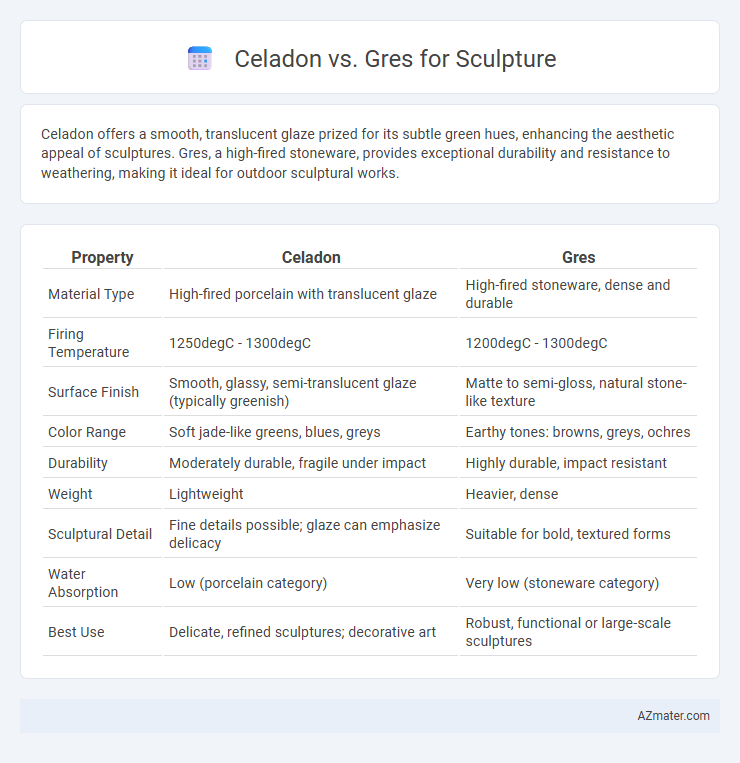Celadon offers a smooth, translucent glaze prized for its subtle green hues, enhancing the aesthetic appeal of sculptures. Gres, a high-fired stoneware, provides exceptional durability and resistance to weathering, making it ideal for outdoor sculptural works.
Table of Comparison
| Property | Celadon | Gres |
|---|---|---|
| Material Type | High-fired porcelain with translucent glaze | High-fired stoneware, dense and durable |
| Firing Temperature | 1250degC - 1300degC | 1200degC - 1300degC |
| Surface Finish | Smooth, glassy, semi-translucent glaze (typically greenish) | Matte to semi-gloss, natural stone-like texture |
| Color Range | Soft jade-like greens, blues, greys | Earthy tones: browns, greys, ochres |
| Durability | Moderately durable, fragile under impact | Highly durable, impact resistant |
| Weight | Lightweight | Heavier, dense |
| Sculptural Detail | Fine details possible; glaze can emphasize delicacy | Suitable for bold, textured forms |
| Water Absorption | Low (porcelain category) | Very low (stoneware category) |
| Best Use | Delicate, refined sculptures; decorative art | Robust, functional or large-scale sculptures |
Understanding Celadon and Gres: Definitions and Origins
Celadon is a type of ceramic glaze originating from ancient China, characterized by its pale green to blue-green color achieved through iron oxide in reduction firing. Gres, or stoneware, refers to a durable, high-fired ceramic material fired at temperatures between 1200degC and 1300degC, known for its strength and density without the need for glaze. Understanding these materials' definitions and origins is essential for sculptors to select the appropriate medium based on aesthetic preferences and functional requirements in sculpture creation.
Historical Significance of Celadon and Gres in Sculpture
Celadon and Gres both hold significant historical roles in sculpture, with celadon emerging from ancient Chinese ceramics renowned for its jade-like glaze symbolizing purity and elegance in East Asian art. Gres, a type of stoneware, became prominent in European sculpture for its durability and versatility, allowing for intricate detailing and lasting outdoor installations. The cultural symbolism of celadon contrasts with the practical robustness of gres, reflecting distinct artistic traditions and material innovations in sculptural history.
Material Composition: Celadon vs Gres
Celadon is a type of ceramic glaze characterized by its smooth, jade-like surface achieved through a high iron oxide content that reacts during firing to produce subtle green to blue hues. Gres, or stoneware, is made from a dense, high-fired clay that typically lacks glaze, offering a sturdy and coarse texture with low porosity, ideal for sculptural durability. The primary difference lies in Celadon's focus on a glazed aesthetic finish derived from iron-rich glaze chemistry, while Gres emphasizes the raw, natural strength of the clay body.
Aesthetic Qualities: Color, Texture, and Finish
Celadon offers a translucent green glaze with soft, muted tones that emphasize smooth textures and subtle variations, ideal for sculptures requiring a delicate, serene appearance. Gres, a stoneware with a matte or satin finish, provides a more robust texture and earthier color palette, enhancing dynamic, tactile qualities in sculptural works. The choice between celadon and gres hinges on whether the artist seeks a refined, glossy finish or a rustic, textured surface for visual and tactile impact.
Workability and Sculpting Techniques
Celadon offers smooth, fine-grained texture and excellent plasticity, making it ideal for detailed carving and intricate sculpting techniques. Gres, a high-fire stoneware, provides greater strength and durability but is less malleable, favoring robust, bold forms over delicate details. Sculptors often choose Celadon for refined surface treatments and complex shapes, while Gres suits structural pieces requiring resilience and rugged textures.
Durability and Longevity: Which Lasts Longer?
Celadon, known for its delicate glaze and translucent quality, offers moderate durability suitable for indoor sculptures but is more prone to chipping and wear over time compared to Gres. Gres, a type of stoneware fired at high temperatures, provides superior strength and resistance to weathering, making it ideal for outdoor sculptures and long-term display. For lasting longevity in sculpture, Gres outperforms Celadon due to its enhanced structural integrity and weather-resistant properties.
Glazing and Surface Treatments
Celadon glaze, known for its translucent, pale green to blue hues, enhances sculptures by emphasizing subtle surface textures and fine details through its smooth, glassy finish. Gres, a type of stoneware clay fired at high temperatures, offers a natural, matte to semi-matte surface ideal for sculptures requiring durability and earthy, tactile qualities. Combining celadon glazing with gres bodies achieves a balance between delicate visual appeal and robust structural integrity, making it a preferred choice for refined ceramic sculptures.
Suitability for Indoor and Outdoor Sculptures
Celadon glaze, known for its smooth, translucent surface and subtle greenish-blue hues, is ideal for indoor sculptures as it is more delicate and sensitive to harsh weather conditions. Gres, a dense, high-fired stoneware, offers superior durability and weather resistance, making it highly suitable for outdoor sculptures exposed to varying environmental elements. The choice between celadon and gres depends on the sculpture's placement, prioritizing aesthetic refinement indoors and structural resilience outdoors.
Cost and Accessibility of Celadon and Gres
Celadon clay typically demands higher production costs due to its specialized glazing process and limited sourcing, making it less accessible for large-scale sculpture projects compared to gres. Gres, or stoneware clay, offers greater affordability and widespread availability, ideal for artists prioritizing budget efficiency without compromising durability. The choice between celadon and gres hinges on balancing the premium finish of celadon against the cost-effective accessibility of gres for sculptural works.
Choosing Between Celadon and Gres: Key Considerations for Sculptors
Choosing between celadon and gres for sculpture involves evaluating durability, aesthetic qualities, and firing requirements. Celadon offers a translucent glaze with subtle green hues ideal for delicate surface details, while gres (stoneware) provides greater strength and resistance to weathering, suited for outdoor or large-scale projects. Sculptors should prioritize celadon for refined indoor art and gres for robust, long-lasting sculptures.

Infographic: Celadon vs Gres for Sculpture
 azmater.com
azmater.com